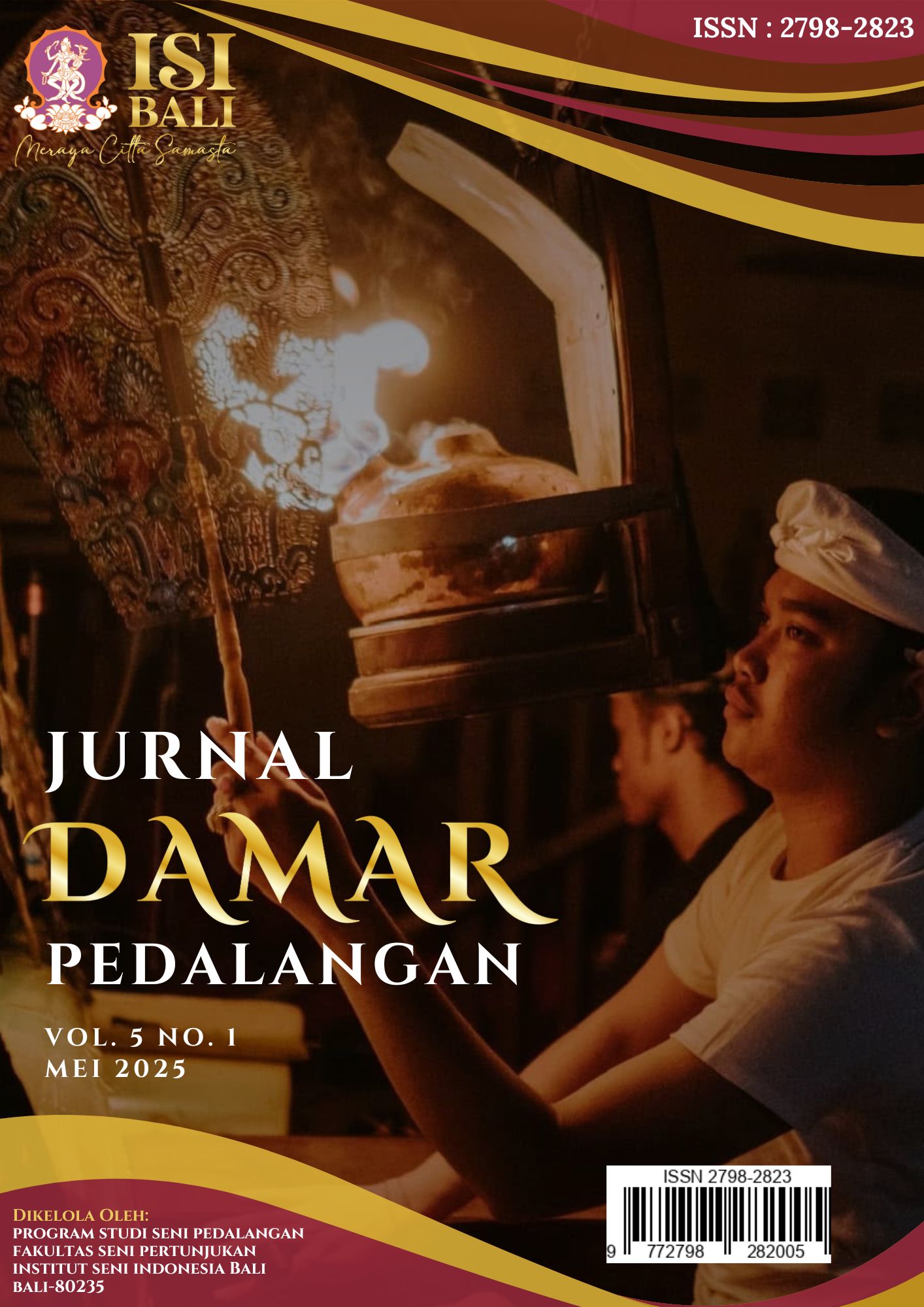PENCIPTAAN KARYA TEATER BAYANG RAGA NUSANTARA DOOMED ROMANCE
DOI:
https://doi.org/10.59997/dmr.v5i1.4825Keywords:
Sri Tanjung, Shadow Theatre, Shadow PuppetAbstract
The performance Shadow Theater: Raga Nusantara adapts traditional Balinese wayang techniques, blending them into a modern theater performance that tells the love story of Sri Tanjung and Sidapaksa, a tale believed by the Banyuwangi community. The Raga Nusantara shadow theater applies methods from Eko Supriyanto’s book “Ikat Kait Impulsif Sarira”—namely Re-Visiting, Re-Questioning, and Re-Interpreting. This work, titled Doomed Romance, translates to a shattered romance or broken love. The shadow theater piece, Doomed Romance, originates from the social phenomena prevalent among the younger generation, particularly concerning the dynamics of romantic relationships. This phenomenon reflects various aspects of young people's lives as they undergo the process of searching for identity, self-existence, and the meaning of love in an ever-changing social context. Romantic relationships often become an important part of their lives, involving not only emotions but also complex social interactions. This work narrates the love journey of Sri Tanjung and Sidapaksa, filled with obstacles and temptations, which form the dynamics of their romantic story. The story carries many moral messages and meanings, particularly in the realms of romance and trust. This tale is considered relevant to the phenomena experienced by the younger generation undergoing the dynamics of social or romantic relationships, which is why the artist chose this story for the Raga Nusantara shadow theater.
Downloads
References
[1] B. Sunarto, Epistemologi Penciptaan Seni. Yogyakarta: IDEA Press Yogyakarta.
[2] E. Supriyanto, Ikat Kait Impulsif Sarira. Yogyakarta: Garudhawaca, 2020.
[3] H. Tejoworo, Imaji dan Imajinasi: Suatu Telaah Filsafat Postmodern. Yogyakarta: Kanisius, 2001.
[4] S. Mulyono, Wayang: Asal Usul, Filsafat dan Masa Depannya. Jakarta: Penerbit PT Gunung Agung, 1978.
[5] W. Indiarti, Lontar Sri Tanjung Kidung Kuno Ujung Timur Jawa. Banyuwangi: Dinas Perpustakaan dan Kearsipan Kabupaten Banyuwangi, 2020.
[6] A. A. M. Djelantik, Estetika Sebuah Pengantar. Bandung: Masyarakat Seni Pertunjukan Indonesia, 2004, hlm. 203.
[7] I. D. K. Wicaksana, “Ideologi dan Strategi Seniman Dalang Dalam Kreativitas Seni Pertunjukan Wayang,” dalam Seminar Seni Pertunjukan, Fakultas Seni Pertunjukan Institut Seni Indonesia Denpasar, Denpasar, 2017, hlm. 1–14.
[8] I. D. K. Wicaksandita, S. N. G. A. Santika, I. D. K. Wicaksana, dan I. G. M. D. Putra, “Nilai-Nilai Estetika Hindu Wayang Kulit Bali: Studi Kasus Internalisasi Jana kertih Melalui Karakter Tokoh Pandawa, Sebagai Media Representasi Ideal Manusia Unggul,” Jurnal Damar Pedalangan, vol. 4, no. 1, hlm. 63–80, 2024, doi: 10.59997/dmr.v4i1.3744.
[9] I. D. K. Wicaksandita, S. Hendra, Saptono, I. W. Sutirtha, dan I. D. K. Wicaksana, “Trans Memori Imajinasi Dalam Pewarisan Nilai Monumental Pertunjukan Wayang Kulit Bagi Masyarakat Hindu di Bali,” Jurnal Penelitian Agama Hindu, vol. 9, no. 1, hlm. 37–56, Jan 2025, doi: 10.37329/jpah.v9i1.3499.
[10] I. D. K. Wicaksandita, “Signifikansi Narasi-Vokal Dan Gerak Yoga Dalam Membangun Karakter Tokoh Pada Suasana Mistik Adegan Setra Pertunjukan Teater Pakeliran Puyung Bolong Telah Ilang Karya I Gusti Putu Sudarta,” Jurnal Damar Pedalangan, vol. 3, no. 2, hlm. 12–12, 2023, doi: 10.59997/dmr.v3i2.2853.
Downloads
Published
Issue
Section
License
Copyright (c) 2025 Gede Putra Arya Bagus Gunawan, I Made Marajaya, I Gusti Putu Sudarta

This work is licensed under a Creative Commons Attribution 4.0 International License.


